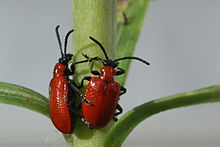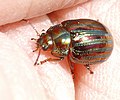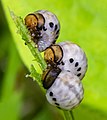Leaf beetle
| Leaf beetles Temporal range:
| |
|---|---|

| |
| Scarlet lily beetle UK
| |
| Scientific classification | |
| Domain: | Eukaryota |
| Kingdom: | Animalia |
| Phylum: | Arthropoda |
| Class: | Insecta |
| Order: | Coleoptera |
| Infraorder: | Cucujiformia |
| Superfamily: | Chrysomeloidea |
| Family: | Chrysomelidae Latreille, 1802 [1] |
| Subfamilies | |
|
See text | |
The insects of the beetle
Leaf beetles are partially recognizable by their
.Adult and
Description
The imagos of leaf beetles are small to medium-sized, i.e. most species range from 1.0 to 18 mm in length, excluding appendages, with just a few larger species such as Alurnus humeralis, which reaches 35 mm. The bodies of most species are domed, and oval in dorsal view (though some are round or elongated), and they often possess a metallic luster or multiple colors. In most specimens, the antennae are notably shorter than head, thorax, and abdomen, i.e. not more than half their combined length. The second antennal segment is of normal size (which differentiates leaf beetles from the closely related longhorn beetles). In most species, the antennal segments are of a more or less equal shape, at most they gradually widen towards the tip, although some Galerucinae in particular have modified segments, mainly in males. The first segment of the antenna in most cases is larger than the following ones. The pronotum of leaf beetles varies between species. In most, it is slightly to highly domed and trapezoidal to rounded-squarish in dorsal view. In some subfamilies such as the Cassidinae and to a lesser extent the Cryptocephalinae, the head is covered by the pronotum and thus not visible from above. The first three sternites are not fused, instead being linked by mobile sutures. Most species possess wings, although the level of development and thus flight ability varies widely, including within a single species, and some are flightless with fused elytra.[4]
Subfamilies
The family includes these subfamilies:
- Bruchinae Latreille, 1802 – bean weevils or seed beetles
- Cassidinae Gyllenhaal, 1813 – tortoise beetles; includes the former "Hispinae"
- Chrysomelinae Latreille, 1802 – broad-bodied leaf beetles
- Criocerinae Latreille, 1804 – asparagus beetles, lily beetles, etc.
- Cryptocephalinae Gyllenhaal, 1813 – cylindrical leaf beetles and warty leaf beetles; includes former "Chlamisinae" and "Clytrinae"
- Donaciinae Kirby, 1837 – longhorned leaf beetles
- Eumolpinae Hope, 1840 – oval leaf beetles
- Galerucinae Latreille, 1802 – includes the former "Alticinae" (flea beetles)
- Lamprosomatinae Lacordaire, 1848
- Sagrinae Leach, 1815 – frog-legged beetles or kangaroo beetles
- Spilopyrinae Chapuis, 1874
- Synetinae LeConte & Horn, 1883 – sometimes considered a tribe of Eumolpinae
Until recently, the subfamily Bruchinae was considered a separate family, while two former subfamilies are presently considered families (
Diet
Chrysomelidae in general are herbivorous. Adults mostly feed on leaves and flowers of
- Bruchinae larvae are seed-borers, usually in seeds of legumes. Many adults feed on pollen, not necessarily that of the larval host.[7] Some do not feed as adults.[8]
- Cassidinae larvae may be leaf miners (many of the former Hispinae), stem borers (e.g. Estigmena) and external leaf feeders (e.g. Leptispa, Oediopalpa).[9]
- Chrysomelinae generally feed on leaves as adults and larvae, though some species feed on flowers instead.[10]
- Criocerinae larvae are usually leaf miners or feed externally on leaves.[9] Some species are gallers instead.[11]
- Eumolpinae larvae feed on roots.[9]
- Most Cryptocephalinae larvae live and feed in leaf litter, making them detritivores, while a few feed on green leaves.[12] A number of Cryptocephalinae have larvae that live in ant nests (myrmecophily), where they feed on dead plant or even dead animal matter.[13]
- The semi-aquatic Donaciinae have larvae feeding on the sap of roots of aquatic plants. In addition to food, they also obtain oxygen this way, from the plant's intercellular spaces. Adults feed on leaves of aquatic plants.[14]
- Galerucinae are quite varied, with larvae living in soil and feeding on rootlets (e.g. Aulacophora, Cerotoma, Diabrotica), mining leaves (some Monoxia) or feeding externally on plants (e.g. Arima, Galeruca, Galerucella).[9]
- Lamprosomatinae larvae feed on green plant parts or graze on bark.[15]
- Sagrinae larvae mostly form galls in stems of shrubs,[9] though Mecynodera balyi instead feeds inside seed pods of Pandorea vines.[16] Adults feed on pollen.[17]
- Spilopyrinae larvae are external leaf feeders.[6]
- Synetinae larvae feed on roots, mainly of trees in cold northern forests.[9]
Natural enemies
A Finnish researcher published an exhaustive paper describing the natural enemies of the alder leaf beetle Plagiosterna aenea and other species of leaf beetles observed in the field.[18] Predators of chrysomelid eggs include true bugs such as Anthocorus nemorum and Orthotylus marginalis.[19] Hoverflies (e.g. Parasyrphus nigritarsis) sometimes lay eggs adjacent to beetle egg clutches and when the fly larva hatches it consumes beetle eggs and young larvae.[19] Larval predators include A. nemorum, the bug Rhacognathus punctatus,[19] and the wasp Symmorphus bifasciatus.[20] Some species of wasps, such as Polistes carolina, have been known to prey upon Chrysomelidae larvae after the eggs are laid in flowers.[21] Adult beetles are consumed by R. punctatus.[19] More information about natural enemies can be found in the articles about the chrysomelid beetles Chrysomela aeneicollis, Phratora laticollis and Phratora vitellinae.
Gallery
-
Altica, larva
-
Bruchinae)
-
Charidotella sexpunctata, pupa
-
Crioceris asparagi
-
Donacia splendida, fossil
-
Labidomera clivicollis, larva
-
Lilioceris lilii
-
Timarcha sp.
-
Xanthogaleruca luteola
-
Several Chrysomelidae spp. larvae feeding on undefined host plant
References
- ^ "Chrysomelidae". Integrated Taxonomic Information System.
- ^ "Family Identification – Chrysomeloidea". University of Florida. Archived from the original on 2006-10-13. Retrieved 2006-11-29.
- ISBN 1-898298-86-6.
- ISBN 3-334-60823-9.
- S2CID 83960406.
- ^ a b "Family CHRYSOMELIDAE". biodiversity.org.au. Retrieved 2023-02-24.
- ^ "Bruchinae". uk beetles. Retrieved 2023-02-24.
- ^ "handbook on seed insects of Prosopis species". www.fao.org. Retrieved 2023-02-24.
- ^ ISBN 978-94-010-7896-2, retrieved 2023-02-23
- ^ "Australian Faunal Directory". biodiversity.org.au. Retrieved 2023-04-18.
- ^ Vencl, F. V.; Nishida, K. (2008). "A new gall-inducing shining leaf beetle (Coleoptera: Chrysomelidae) from Thailand and its relevance to the evolution of herbivory in leaf beetles" (PDF). In Jolivet, P.; Santiago-Blay, J.; Schmitt, M. (eds.). Research on Chrysomelidae. Leiden, Netherlands: Brill. pp. 246–259.
- ^ "Subfamily Cryptocephalinae - Case-bearing Leaf Beetles". bugguide.net. Retrieved 2023-02-24.
- PMID 26798319.
- PMID 32528063.
- ^ "Subfamily Lamprosomatinae". bugguide.net. Retrieved 2023-02-24.
- ISSN 1175-5334.
- ^ "Subfamily Sagrinae Leach, 1815". biodiversity.org.au. Retrieved 2023-02-24.
- ^ Kanervo, V. (1946). "Tutkimuksia lepän lehtikuoriaisen, Melasoma aenea L. (Col., Chrysomelidae), luontaisista vihollisista. (Ref.: Studien über die natürlichen Feinde des Erlenblattkäfers, Melasoma aenea L. (Col., Chrysomelidae)". Annales Zoologici Societatis Zoologicae Botanicae Fennicae "Vanamo". 12 (3): 1–202..
- ^ a b c d Rank, N. E.; Smiley, J. T.; Köpf, A. (1996). "Natural enemies and host plant relationships for chrysomeline leaf beetles feeding on Salicaceae". In P. H. Jolivet; M. L. Cox (eds.). Chrysomelidae Biology. Vol. 2: Ecological Studies. Amsterdam: SPB Publishing. pp. 147–171.
- ^ Blüthgen, P. (1961). Die Faltenwespen Mitteleuropas (Hymenoptera, Diploptera). Berlin: Akademie Verlag.
- . Retrieved 2014-09-17.
Bibliography
- Löbl, Ivan; Smetana, Ales, eds. (2010). "Chrysomelidae". Chrysomeloidea. Catalogue of Palaearctic Coleoptera. Vol. 6. ISBN 978-90-04-26091-7.
- Riley, Edward G.; Clark, Shawn M.; Seeno, Terry N. (2003). Catalog of the leaf beetles of America north of Mexico (Coleoptera: Megalopodidae, Orsodacnidae and Chrysomelidae, excluding Bruchinae). Special Publication. Vol. 1. Sacramento, CA: The Coleopterists Society. ISBN 0-9726087-1-0. Retrieved 2023-12-10.





















